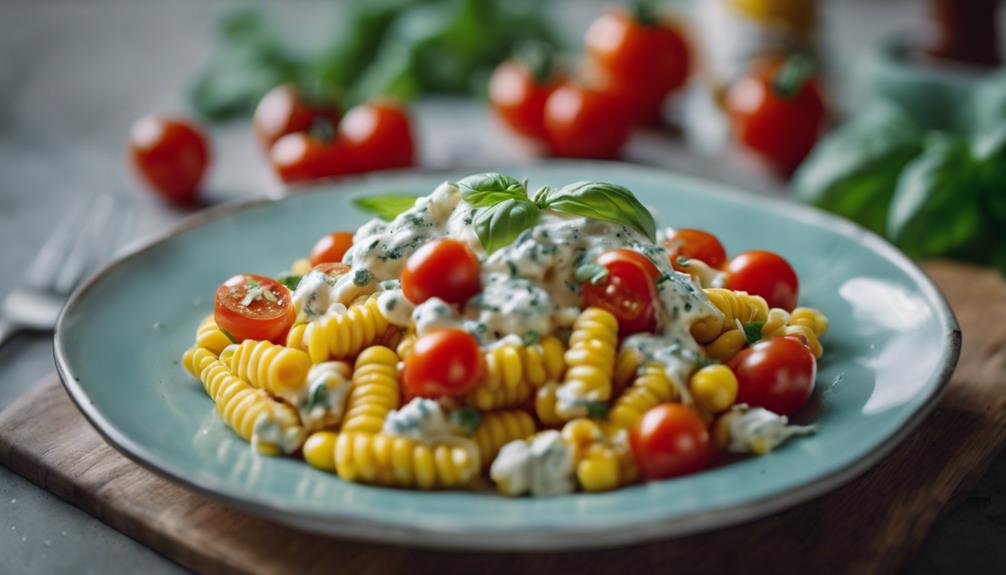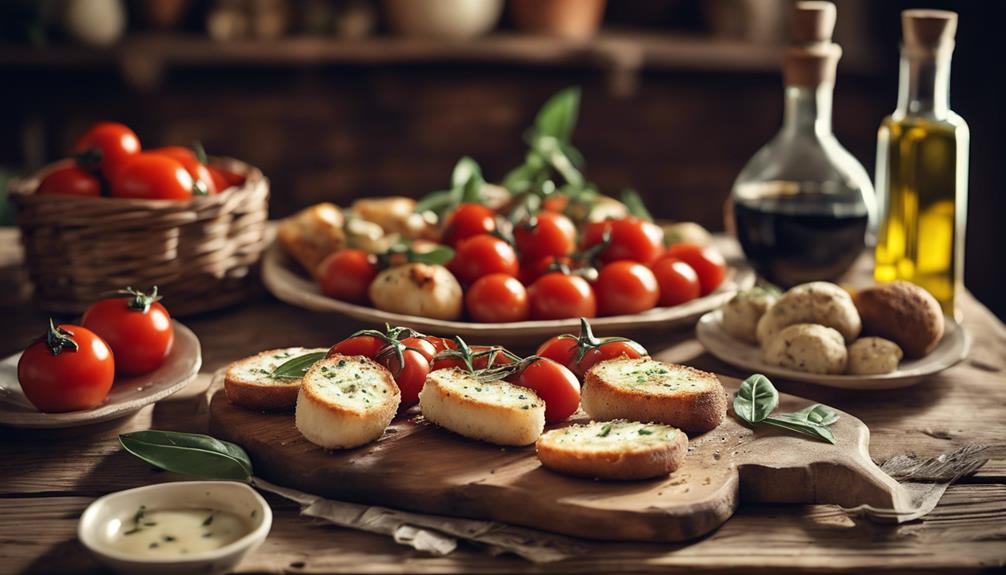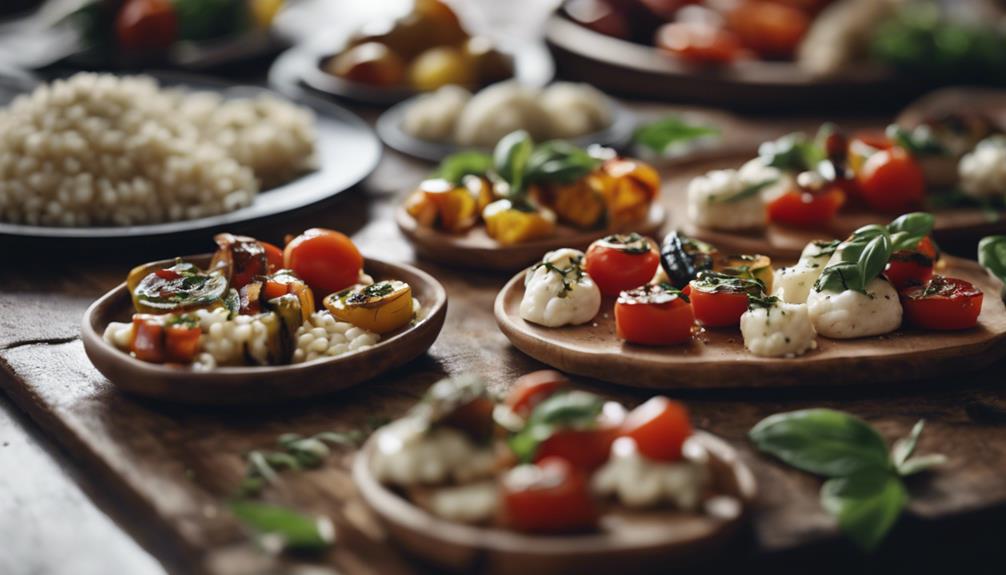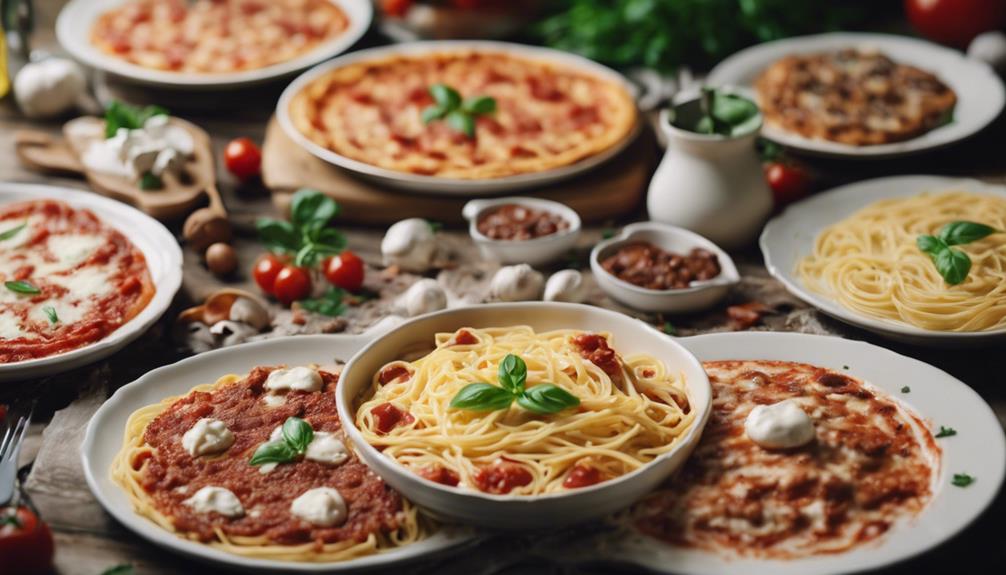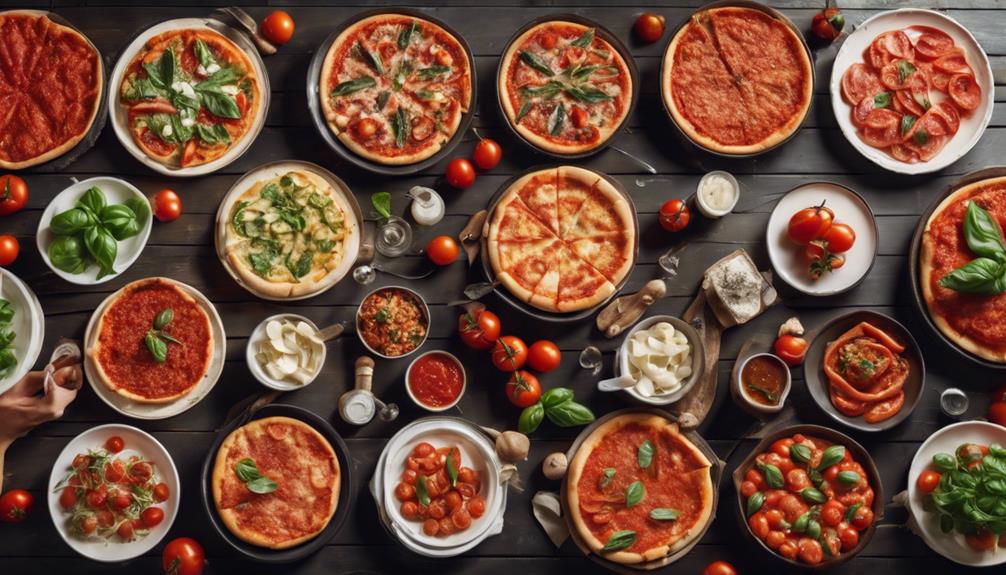Enjoy the vibrant flavors of summer with a Tomato and Corn Pasta dish topped with a rich Basil Ricotta Sauce for a burst of freshness in every bite. To make this savory meal, you will need a large pot, skillet, and cutting board. Combine fresh ricotta with basil leaves, garlic, and lemon zest for a luxurious sauce. Sauté corn and tomatoes to perfection before layering them over al dente pasta for a delicious combination. Bake and serve hot, garnishing with basil leaves for added flavor and presentation. Treat yourself to a delightful summer meal filled with seasonal goodness.
Key Takeaways
- Fresh cherry tomatoes and sweet corn create a vibrant and flavorful base.
- Basil ricotta sauce adds richness and freshness to the dish.
- Sauté corn and tomatoes with herbs for enhanced flavors.
- Bake pasta with sauce, tomatoes, and corn for a comforting meal.
- Garnish with fresh basil leaves for aroma and visual appeal.
Ingredients for Tomato Corn Pasta
To make the Tomato Corn Pasta, gather fresh cherry tomatoes and sweet corn. The cherry tomatoes will provide a burst of sweetness to the dish, while the fresh corn adds a delightful crunchy texture and sweet flavor.
These ingredients form the base of the pasta dish, offering a colorful and flavorful combination when mixed with the basil ricotta sauce.
The cherry tomatoes, known for their vibrant color and juicy sweetness, complement the earthy sweetness of the corn, creating a harmonious balance in each bite. The corn, with its crisp kernels, adds a satisfying texture that contrasts beautifully with the softness of the tomatoes.
When combined, these ingredients work in unison to elevate the overall taste profile of the dish, making it a perfect choice for a summer meal. The freshness and quality of the cherry tomatoes and sweet corn are essential to achieving the full flavor potential of this delightful Tomato Corn Pasta.
Gather Your Cooking Equipment
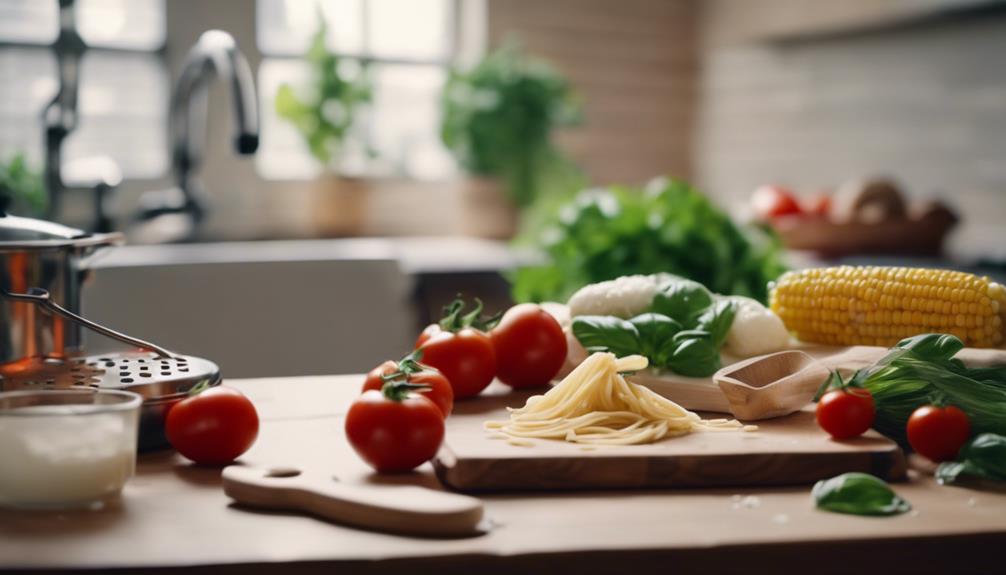
Gather your cooking equipment, making sure you have all the necessary tools and utensils for preparing the Tomato and Corn Pasta with Basil Ricotta Sauce.
Begin by readying a large pot of salted water for boiling the pasta until al dente.
Equip yourself with a skillet for cooking the corn and tomatoes to perfection.
A cutting board and knife will be essential for prepping the fresh ingredients, while stirring utensils will aid in combining the flavors.
Remember to have a grater on hand for the grated Parmesan that will beautifully complement the dish.
Additionally, make certain you have a colander for draining the pasta and measuring cups and spoons for precise ingredient quantities.
Setting up a clean and organized workspace with ample lighting and easy access to all ingredients will facilitate a seamless cooking experience.
Having these tools at your disposal will allow you to create a delicious Tomato and Corn Pasta with Basil Ricotta Sauce effortlessly.
Prepare the Basil Ricotta Sauce
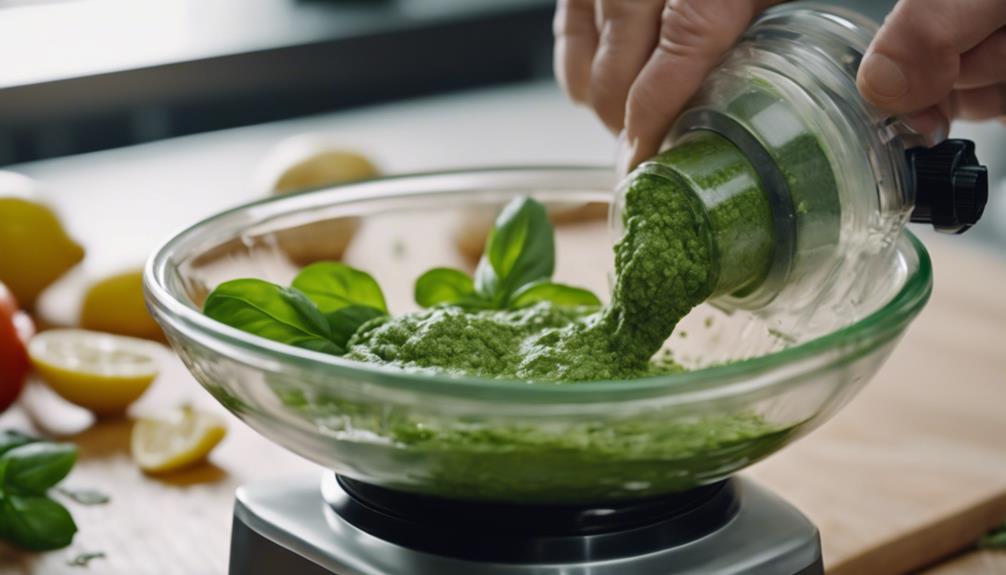
To prepare the Basil Ricotta Sauce, start by blending fresh ricotta cheese with basil leaves. Whisk the ingredients together until you achieve a smooth and creamy texture.
This sauce can be further enhanced with seasonings like garlic, lemon zest, or black pepper for added flavor depth.
Ricotta and Basil Blend
Consider blending the creamy ricotta cheese with fresh basil leaves to create the flavorful Basil Ricotta Sauce for the Tomato and Corn Pasta dish.
The Basil Ricotta Sauce is a combination of the smooth ricotta cheese and the aromatic basil, resulting in a rich and herby flavor profile that enhances the overall taste of the pasta.
To make this sauce, simply add the ricotta cheese and fresh basil leaves to a food processor and blend until smooth.
The amount of basil can be adjusted based on personal preference, allowing you to customize the intensity of the basil flavor in the sauce.
This blend of ricotta and basil creates a harmonious balance with the sweetness of the tomatoes and corn in the dish, offering a delightful burst of freshness in every bite.
The creamy texture of the ricotta complements the vibrant herbaceous notes of the basil, making the Basil Ricotta Sauce a perfect accompaniment to the Tomato and Corn Pasta.
Whisk Until Smooth
Whisk together the ricotta cheese, fresh basil leaves, garlic, lemon zest, olive oil, salt, and pepper until smooth to prepare the Basil Ricotta Sauce.
The ricotta cheese contributes a creamy texture, while the fresh basil infuses the sauce with a delightful herby essence.
Incorporating garlic and lemon zest adds layers of flavor complexity, enhancing the overall taste profile.
Olive oil plays an essential role in emulsifying the ingredients, creating a harmonious blend, and introducing a rich, fruity undertone to the sauce.
Season the Basil Ricotta Sauce with salt and pepper to your preference, adjusting the flavors as necessary to achieve a well-balanced dish.
This meticulous whisking process ensures that all components are thoroughly combined, resulting in a velvety and flavorful sauce that perfectly complements the fresh summer ingredients in the Tomato and Corn Pasta dish.
Cook the Pasta Al Dente
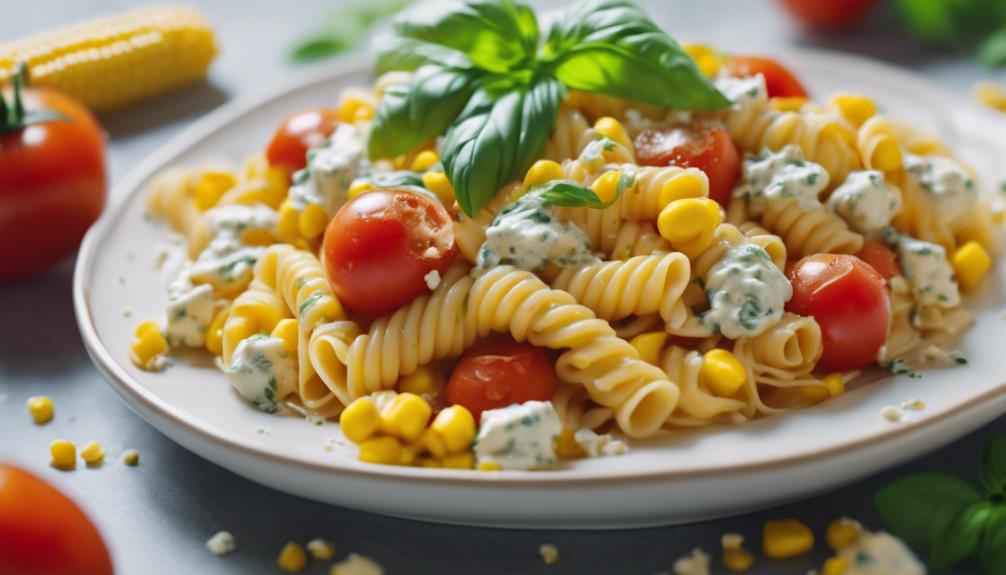
Achieve the perfect texture by cooking the pasta until it's firm to the bite, known as al dente. To start, bring a large pot of salted water to a rolling boil. Adding salt to the water enhances the pasta's flavor during the cooking process.
Once the water is boiling, carefully add the pasta, ensuring it's fully submerged. Stir the pasta occasionally to prevent sticking and cook according to the package instructions. It's important to taste the pasta as it nears the end of the suggested cooking time to achieve the desired al dente texture.
Al dente pasta offers a slight resistance when chewed and is ideal for holding sauces and flavors. Overcooked pasta can become mushy and lose its texture, affecting the overall dish's quality. Remember that cooking times can vary based on the type and brand of pasta, so following the package instructions is key to achieving perfectly al dente pasta for your Tomato and Corn Pasta With Basil Ricotta Sauce.
Sauté Fresh Corn and Tomatoes
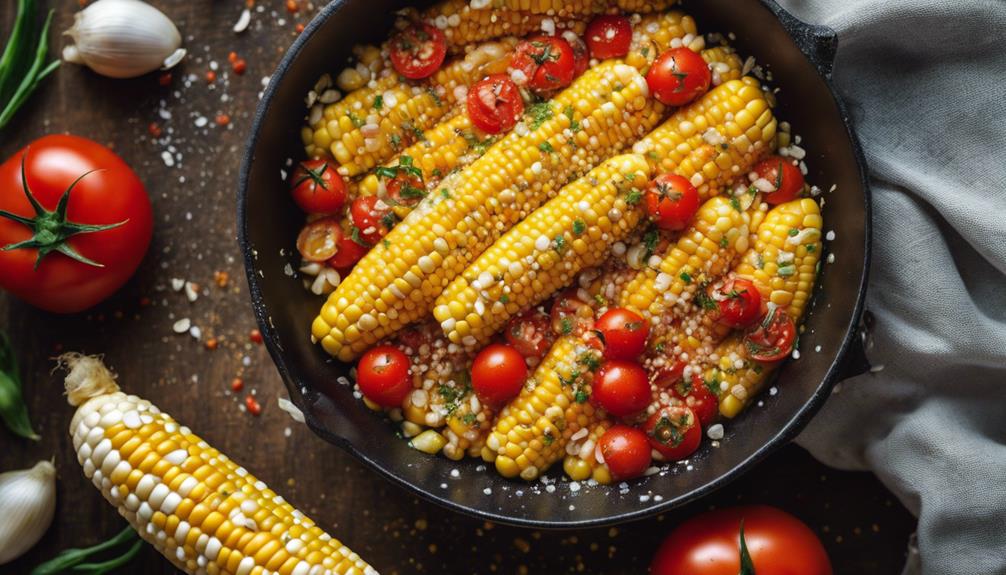
When sautéing fresh corn and tomatoes, you prep the summer produce to extract their vibrant flavors.
Enhancing these vegetables with herbs like basil and oregano elevates the dish's taste profile.
Achieving optimal caramelization through careful cooking techniques guarantees a delightful addition to your pasta.
Prep Fresh Summer Produce
To prepare the fresh summer produce for this dish, begin by sautéing fresh corn and tomatoes in olive oil to enhance their natural sweetness and flavors. The corn's slight char and the tomatoes' tender juiciness combine to create a delightful base for the pasta, infusing it with the essence of summer. Below is a table summarizing the benefits of sautéing fresh corn and tomatoes for the pasta dish:
| Benefits of Sautéing Fresh Corn and Tomatoes |
|---|
| Enhances natural sweetness and flavors |
| Adds depth and richness with garlic-infused oil |
| Creates a colorful and vibrant dish |
Sautéing these ingredients together helps meld their flavors, resulting in a cohesive sauce that perfectly complements the pasta. The burst of summer freshness from the freshly sautéed corn and tomatoes elevates the overall taste profile of the basil ricotta pasta, making it a truly invigorating and satisfying summer meal.
Enhance Flavors With Herbs
Enhancing the flavors of your dish, consider adding fresh herbs like basil to elevate the aroma and taste of the sautéed corn and tomatoes.
Here are four ways to enhance the flavors of your dish:
- Basil: Adding fresh basil to the sautéed corn and tomatoes brings a burst of freshness and a hint of sweetness that complements the natural flavors of the vegetables.
- Garlic: Infusing the sautéed corn and tomatoes with garlic provides a savory depth and richness to the dish, balancing out the sweetness of the corn and tomatoes.
- Olive Oil: Cooking the corn and tomatoes in olive oil helps to caramelize them, bringing out their natural sugars and intensifying their flavors.
- Herb Combination: The combination of basil, garlic, and olive oil creates a harmonious blend of flavors that enhances the overall taste profile of the dish, making it a vibrant and aromatic summer delight.
Achieve Perfect Caramelization
To guarantee ideal caramelization when sautéing fresh corn and tomatoes, make sure your skillet is hot with olive oil to create a golden brown color and enhance flavors. Heat the skillet over medium-high heat and add a generous amount of olive oil to coat the bottom. This step is essential as the high heat and oil help caramelize the natural sugars in the vegetables, bringing out their sweetness and depth of flavor.
As you sauté the corn and tomatoes, stir occasionally to make sure even browning without overcrowding the skillet. Proper caramelization intensifies the flavors of the vegetables, providing a rich and savory foundation for the pasta dish.
The caramelization process not only enhances the taste of the corn and tomatoes but also adds complexity and depth to the overall flavor profile of the basil ricotta sauce, elevating the summery essence of the dish. Remember, achieving perfect caramelization is key to unlocking the full potential of this fresh summer recipe.
Mix Pasta With Corn and Tomatoes
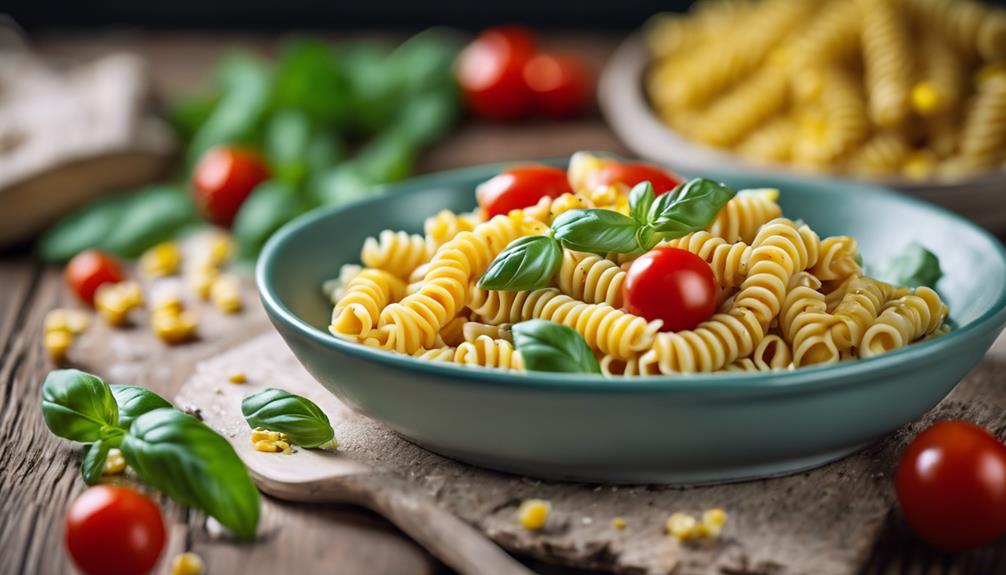
Combine the sweet cherry tomatoes and fresh corn to infuse your pasta dish with the vibrant flavors of summer. The juicy tomatoes add a pop of acidity and brightness, while the sweet corn brings a subtle sweetness to the dish.
Here are four reasons why mixing pasta with sweet corn and tomatoes can elevate your pasta recipe:
- Enhanced Flavor: The sweet corn and juicy tomatoes create a harmonious blend of flavors, adding depth and freshness to your pasta dish.
- Colorful Presentation: The combination of vibrant red tomatoes and golden corn kernels not only enhances the visual appeal but also signifies the freshness of the ingredients.
- Textural Balance: The tender corn kernels and juicy tomatoes provide a delightful contrast in textures, making each bite a satisfying experience.
- Summer Vibes: By incorporating these seasonal ingredients, you bring the essence of summer to your table, making every meal a celebration of the sunny season.
Mixing pasta with sweet corn and tomatoes is a delightful way to infuse your dish with the essence of summer.
Layer Pasta With Ricotta Sauce
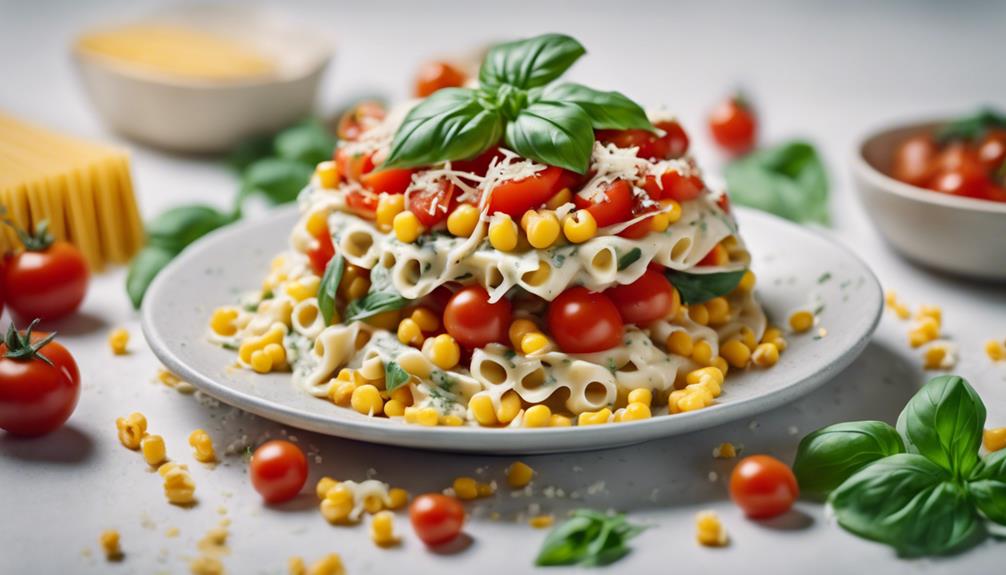
Infuse your pasta dish with a creamy and flavorful twist by layering it with basil ricotta sauce. The addition of ricotta sauce between pasta layers provides a rich and decadent texture, elevating the overall taste of the dish.
The basil infused in the ricotta sauce introduces a fresh and aromatic herbaceous flavor, enhancing the sensory experience of each bite. By layering the pasta with basil ricotta sauce, you create a harmonious balance of flavors and textures that complement each other perfectly.
Furthermore, incorporating ricotta sauce between the pasta layers not only enriches the dish in terms of taste but also helps to keep it moist and delicious when baked. The creamy consistency of the ricotta sauce seeps into the pasta layers, ensuring a delectable and satisfying outcome.
Embrace the indulgent combination of ricotta and basil as you layer your pasta, transforming a simple dish into a culinary delight that's sure to impress your taste buds.
Bake and Serve Hot
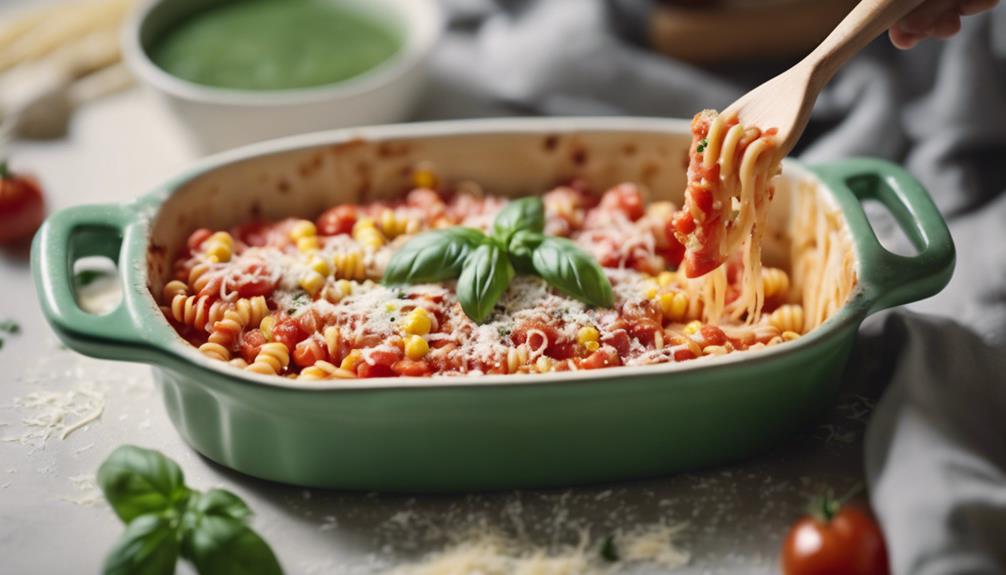
Bake the Tomato and Corn Pasta with Basil Ricotta Sauce until it's heated through and ready to serve hot. Here are four crucial steps to guarantee a delightful and flavorful summer dinner:
- Preheat your oven to 375°F and prepare a large pot of salted water to cook the pasta until al dente.
- Mix the cooked pasta with the creamy ricotta and basil sauce, adding cherry tomatoes and fresh corn for a burst of flavor.
- Transfer the pasta mixture to a baking dish, ensuring an even layer, and cover it with foil before placing it in the preheated oven.
- Bake the dish for 20-25 minutes, or until the pasta is heated through and the flavors have melded together perfectly. Serve hot for a comforting and satisfying meal that highlights the freshness of summer ingredients.
Garnish With Fresh Basil Leaves
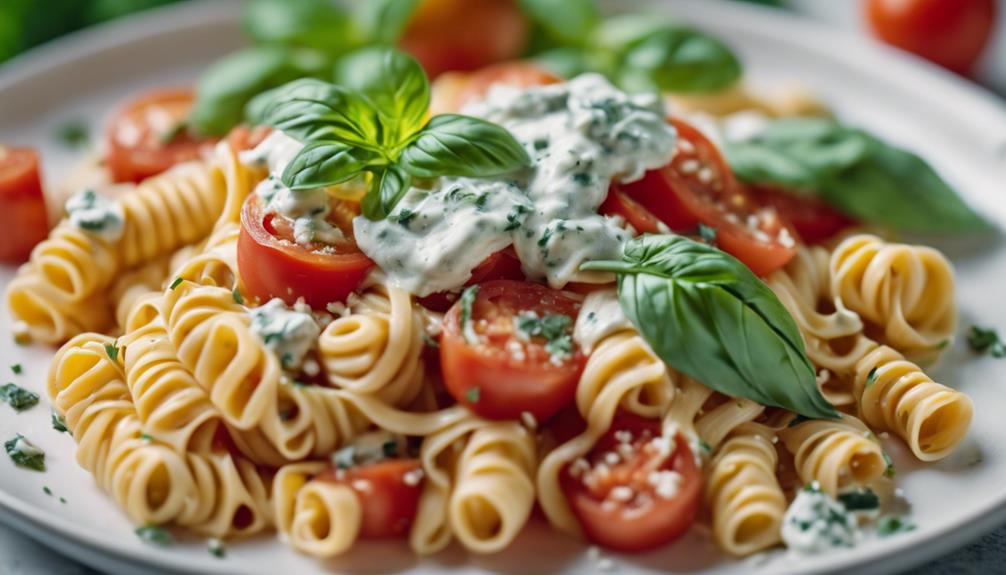
Garnishing your Tomato and Corn Pasta with Basil Ricotta Sauce with fresh basil leaves not only adds a pop of color but also infuses each bite with a delightful herbaceous flavor.
The aromatic notes from the basil complement the creamy ricotta sauce, creating a harmonious blend of tastes.
Remember to tear or chop the basil leaves just before serving to retain their freshness and vibrancy.
Herbaceous Basil Addition
Enhance the aroma and taste of your Tomato and Corn Pasta with a generous scattering of fresh basil leaves. Basil, a staple herb in Mediterranean cuisine, complements the flavors of tomatoes and corn, providing a fragrant and herbaceous touch to your dish.
Here's why adding fresh basil leaves to your Tomato and Corn Pasta with Basil Ricotta Sauce is a must:
- Flavor Boost: Fresh basil leaves bring a burst of freshness to the dish, enhancing the overall taste with their aromatic profile.
- Complementary Pairing: Basil's natural affinity with tomatoes and corn creates a harmonious blend of flavors that will tantalize your taste buds.
- Visual Appeal: The vibrant green color of basil leaves adds a pop of freshness and visual appeal to the pasta, making it visually enticing.
- Nutritional Benefits: Apart from flavor, basil is rich in antioxidants, offering a nutritious element to your summery pasta recipe.
Enhancing Visual Appeal
To elevate the visual appeal of your Tomato and Corn Pasta with Basil Ricotta Sauce, consider garnishing with fresh basil leaves for a vibrant touch of color and aroma.
Adding these bright green basil leaves not only adds a pop of color to the dish but also provides a fragrant and herbaceous scent that enhances the overall sensory experience.
The visual contrast created by the vivid green basil leaves against the red tomatoes and yellow corn contributes to the dish's aesthetic appeal.
Enjoy Your Summer Pasta Dish
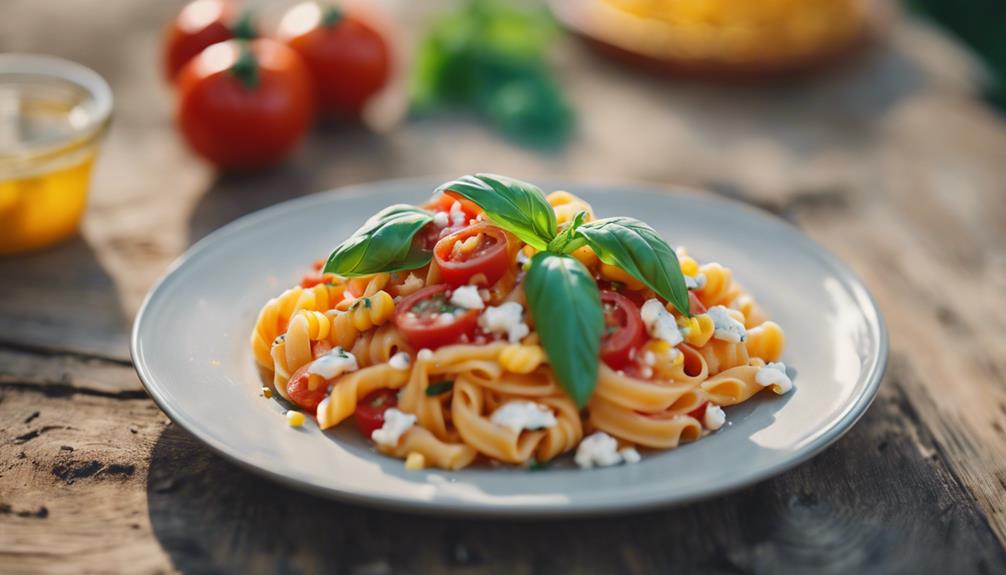
Savor the delightful flavors of summer with this tomato and corn pasta dish featuring a creamy basil ricotta sauce. Here are some tips to fully enjoy your summer pasta dish:
- Perfecting the Pasta: Guarantee your pasta is cooked al dente to maintain a firm texture that complements the creaminess of the sauce.
- Grated Goodness: When adding grated Parmesan cheese to the dish, do so gradually while stirring continuously to prevent clumping and evenly distribute the cheesy flavor.
- Freshness is Key: Use the freshest ingredients possible, such as ripe cherry tomatoes and sweet corn, to enhance the overall taste and vibrancy of the dish.
- Serve with Style: Garnish your pasta with a few fresh basil leaves and a drizzle of high-quality olive oil just before serving to elevate the presentation and flavor profile.
Frequently Asked Questions
Can I Substitute Ricotta With Another Cheese?
Yes, you can substitute ricotta with another cheese. Consider using a creamy cheese like mascarpone or goat cheese for a similar texture. Experiment with different cheeses to find the perfect substitute for your dish.
How Can I Make This Dish Vegan-Friendly?
Want to make this dish vegan-friendly? Swap out the ricotta for a creamy cashew or almond-based alternative. Blend with fresh basil and a squeeze of lemon for a deliciously dairy-free sauce that's perfect for summer!
Can I Use Frozen Corn Instead of Fresh?
Yes, you can use frozen corn instead of fresh in the recipe. Simply thaw the frozen corn before adding it to the dish. This substitution will work well and still maintain the delicious flavors of the dish.
How Can I Store Leftovers Properly?
To store leftovers properly, refrigerate them in an airtight container within two hours of cooking. When reheating, make sure food reaches a safe temperature throughout. Enjoy your meal!
Can I Add Protein Like Chicken or Shrimp?
If you desire a heartier meal, consider complementing your dish with protein like chicken or shrimp. It will add a delightful touch to your pasta, making it a satisfying meal that caters to your preference.
Can I Substitute Cherry Tomatoes for Regular Tomatoes in the Summer Pasta Dish?
Yes, you can substitute cherry tomatoes for regular tomatoes in a summer pasta dish. It will add a slightly sweeter and tangier flavor to the spaghetti with tomato sauce recipe, giving it a refreshing twist. Plus, the burst of color from the cherry tomatoes will make the dish even more vibrant and appetizing.
Conclusion
To sum up, this tomato and corn pasta with basil ricotta sauce is a delightful dish that perfectly captures the essence of summer.
The combination of fresh ingredients and creamy sauce creates a harmony of flavors that will leave your taste buds satisfied.
As you take a bite of this delectable pasta, imagine yourself sitting in a sun-drenched garden, surrounded by the sights and sounds of a summer day.
This dish isn't just a meal, but a culinary journey through the flavors of the season.
